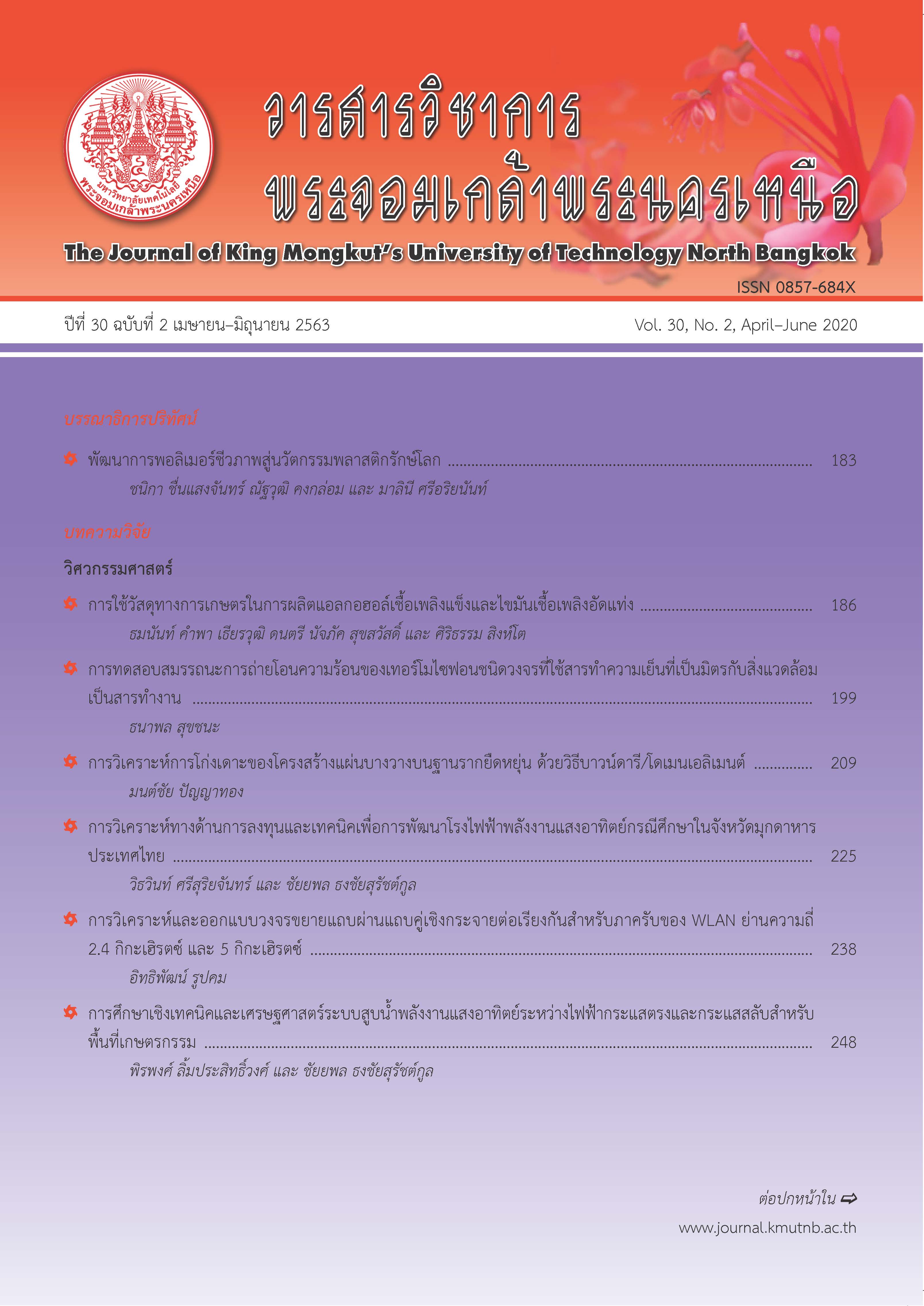การทดสอบสมรรถนะการถ่ายโอนความร้อนของเทอร์โมไซฟอนชนิดวงจรที่ใช้สารทำความเย็นที่เป็นมิตรกับสิ่งแวดล้อมเป็นสารทำงาน
Main Article Content
บทคัดย่อ
งานวิจัยนี้เป็นการศึกษาเชิงทดลองเพื่อทดสอบสมรรถนะของเทอร์โมไซฟอนชนิดวงจรที่ใช้สารทำความเย็นกลุ่มที่เป็นมิตรกับสิ่งแวดล้อมเป็นสารทำงาน เทอร์โมไซฟอนทำด้วยท่อทองแดงโดยมีความสูงรวมเท่ากับ 1000 มม. ซึ่งมีอัตราส่วนพื้นที่ภาคตัดของท่อนำไอระเหยต่อท่อนำของเหลวเท่ากับ 4.46 ใช้สารทำความเย็น R134a, R32, R404a, R407C และ R410A เป็นสารทำงานด้วยอัตราการบรรจุเท่ากับ 20% ของปริมาตรระบบ ทำการทดลองในแนวตั้งตรงโดยให้ความร้อนด้วยฮีตเตอร์ไฟฟ้าแบบฟลักซ์ความร้อนคงที่ในช่วง 8.36–50.15 กิโลวัตต์/ตารางเมตร ขณะที่คอนเดนเซอร์ระบายความร้อนด้วยน้ำเย็นอุณหภูมิทางเข้า 25°ซ และอัตราการไหลเชิงมวล 6.67×10–3 กก./วินาที จากผลการทดลองพบว่า สารทำความเย็นต่างชนิดกันมีผลต่อสมรรถนะในการถ่ายโอนความร้อนของเทอร์โมไซฟอนชนิดวงจรที่แตกต่างกัน โดย R32, R134a, R410A, R407C และ R404A มีค่าความต้านทานความร้อนรวมต่ำสุดเท่ากับ 0.1124, 0.1140, 0.1145, 0.1180 และ 0.1199°ซ/วัตต์ ตามลำดับ นอกจากนี้ยังพบว่า R32, R404A และ R410A มีค่าความต้านทานความร้อนรวมต่ำสุดเมื่อฟลักซ์ความร้อนเท่ากับ 30 กิโลวัตต์/ตารางเมตร ในขณะที่ R134a และ R407C มีค่าความต้านทานความร้อนรวมต่ำสุดเมื่อ ฟลักซ์ความร้อนเท่ากับ 40 กิโลวัตต์/ตารางเมตร
Article Details
บทความที่ลงตีพิมพ์เป็นข้อคิดเห็นของผู้เขียนเท่านั้น
ผู้เขียนจะต้องเป็นผู้รับผิดชอบต่อผลทางกฎหมายใดๆ ที่อาจเกิดขึ้นจากบทความนั้น
เอกสารอ้างอิง
[2] C. Nimmol and W. Ritthong, “Application of thermosyphon heat pipes for paddy dehydration process,” KKU Research Journal, vol.17, no. 6, pp. 862–879, 2012 (in Thai).
[3] S. Nakkaew and S. Wongwises, “Application of heat pipes to enhance performance of air conditioning system,” KMUTT Research and Development Journal, vol. 41, no. 3, pp. 267–279, 2018 (in Thai).
[4] A. Siricharoenpanich, S. Rittidech, and B. Bubphachot, “Performance improvement of air conditioner by using closed-loop oscillating heat pipe with check valves,” Journal of Science and Technology MSU, vol. 33, no. 3, pp. 294–299, 2014 (in Thai).
[5] S. Kanjai and S. Mongkon, “Dehumidification potentiality of evaporative cooling system for residential home by heat pipe,” Engineering Journal CMU, vol. 24, no. 1, pp. 166–179, 2017 (in Thai).
[6] S. Sichamnan, T. Chompookham, and S. Rittidech, “Efficiency enhancement of solar panels using copper mesh wick heat pipe,” UBU Engineering Journal, vol. 9, no. 1, pp. 11–22, 2016 (in Thai).
[7] W. Srimuang and D. Kokpimai, “Enhancement of heat transfer efficiency of flat two phase closed thermosyphon by using copper nano powder with water as working fluid,” Burapha Science Journal, vol. 18, no. 1, pp. 125–136, 2013 (in Thai).
[8] T. Sukchana and V. Thadniam, “A technique of heat pipe filling with the refrigerants vapor compression method,” The Journal of KMUTNB, vol. 29, no. 1, pp. 93–102, 2019 (in Thai).
[9] Z. Tong, X-H Liu, Z. Li, and Y. Jiang, “Experimental study on the effect of fill ratio on an R744 twophase thermosyphon loop,” Applied Thermal Engineering, vol. 99, pp. 302–312, 2016.
[10] S. Chen and J. Yang, “Loop thermosyphon performance study for solar cells cooling,” Energy Conversion and Management, vol. 121, pp. 297–304, 2016.
[11] J. Cao, G. Pei, D. Jiao, P. Zhao, J. Li, and Y. Wang, “Experimental investigation on control-lable loop thermosyphon with a reservoir,” Applied Thermal Engineering, vol. 126, pp. 322–329, 2017.
[12] T. Sukchana and N. Pratinthong, “Effect of bending position on heat transfer performance of R-134a two-phase close loop thermosyphon with an adiabatic section using flexible hoses,” International Journal of Heat and Mass Transfer, vol. 114, pp. 527–535, 2017.
[13] C. Kondou, S. Umemoto, S. Koyama, and Y. Mitooka, “Improving the heat dissipation performance of a looped thermosyphon using low-GWP volatile fluids R1234ze (Z) and R1234ze (E) with a superhydrophilic boiling surface,” Applied Thermal Engineering, vol. 118, pp. 147–158, 2017.
[14] Z. Tong, X-H Liu, and Y. Jiang, “Three typical operating states of an R744 two-phase thermosyphon loop,” Applied Energy, vol. 206, pp. 181–192, 2017.
[15] Z. Tong, X-H Liu, and Y. Jiang, “Experimental study of the self-regulating performance of an R744 two-phase thermosyphon loop,” Applied Energy, vol. 186, pp. 1–12, 2017.
[16] H. Zhang, Z. Shi, K. Liu, S. Shao, T. Jin, and C. Tian, “Experimental and numerical investigation on a CO2 loop thermosyphon for free cooling of data centers,” Applied Thermal Engineering, vol. 111, pp. 1083–1090, 2017.
[17] H. Cao, T. Ding, Z. He, and Z. Li, “Research on the refrigerant column height in the downcomer of a two-phase loop thermosyphon,” International Journal of Refrigeration, vol. 94, pp. 40–48, 2018.
[18] F. Li, J. Gao, X. Shi, L. Xu, and K. Zhu, “Evaluation of R404a single loop thermosyphon for shaft cooling in motorized spindle,” Applied Thermal Engineering, vol. 142, pp. 262–268, 2018.
[19] Y. Liu, Z. Li, Y. Li, S. Kim, and Y. Jiang, “Experimental investigation of geyser boiling in a two-phase closed loop thermosyphon with high filling ratios,” International Journal of Heat and Mass Transfer, vol. 127, pp. 857–869, 2018.
[20] P. Zhang, W. Shi, X. Li, B. Wang, and G. Zhang, “A performance evaluation index for two-phase thermosyphon loop used in HVAC systems,” Applied Thermal Engineering, vol. 131, pp. 825–836, 2018.
[21] G. Gorecki, “Investigation of two-phase thermosyphon performance filled with modern HFC refrigerants,” Heat and Mass Transfer, vol. 54, pp. 2131–2143, 2018.
[22] American Society of Heating, Refrigerating and Air-Conditioning Engineers, I-P ed., Atlanta, GA, 2005, pp. 20.1–20.75.
[23] D.A. Reay and P.A. Kew, Heat Pipes: Theory, Design and Applications, 5 th ed., Jordan Hill, 2006, pp. 29–101.

